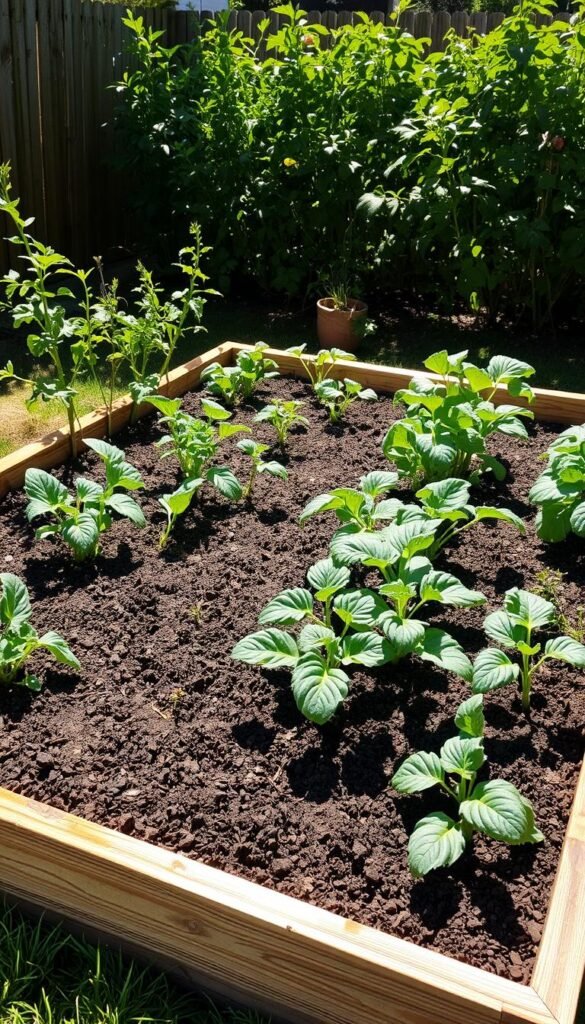Starting a garden doesn’t have to be overwhelming. With raised beds, you skip common struggles like poor soil or limited space. These setups give you control, making gardening simpler and more rewarding.
Even if you’ve struggled with houseplants before, don’t worry. Raised beds offer better drainage and fewer weeds. You’ll see quick results with the right plants, like leafy greens or root crops. They’re forgiving and grow fast, perfect for first-timers.
Later, we’ll share tips on soil prep and pairing vegetables for better yields. Ready to dig in? Let’s make your garden thrive!
Why Raised Beds Are Perfect for Beginner Gardeners
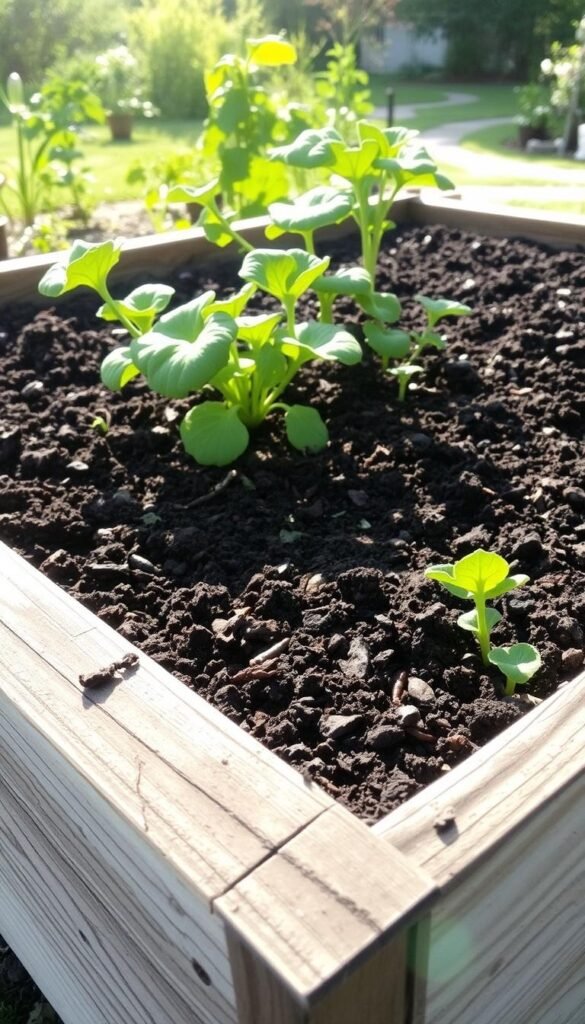
New to gardening? Raised beds remove common frustrations from day one. These structures give you control over soil quality and garden conditions, turning challenges into easy wins.
Better Soil Control and Drainage
Forget battling clay or rocks. Raised beds let you mix the perfect soil blend—loose, nutrient-rich, and well-draining. Roots thrive with 6+ inches of space to grow, and waterlogging becomes rare.
Warmer Soil for Longer Growing Seasons
Elevated soil warms faster in spring, extending your growing season by 2–3 weeks. In colder zones like Saskatchewan’s Zone 3, this means beating short summers for robust crops.
Easy Access and Less Weeding
No more back strain! Frames 10–12 inches tall make planting and weeding effortless. Plus, fewer weeds sneak in—some gardeners report 90% less maintenance. Ready to build a raised bed? Your future harvest will thank you.
Chives: The Unkillable Starter Plant
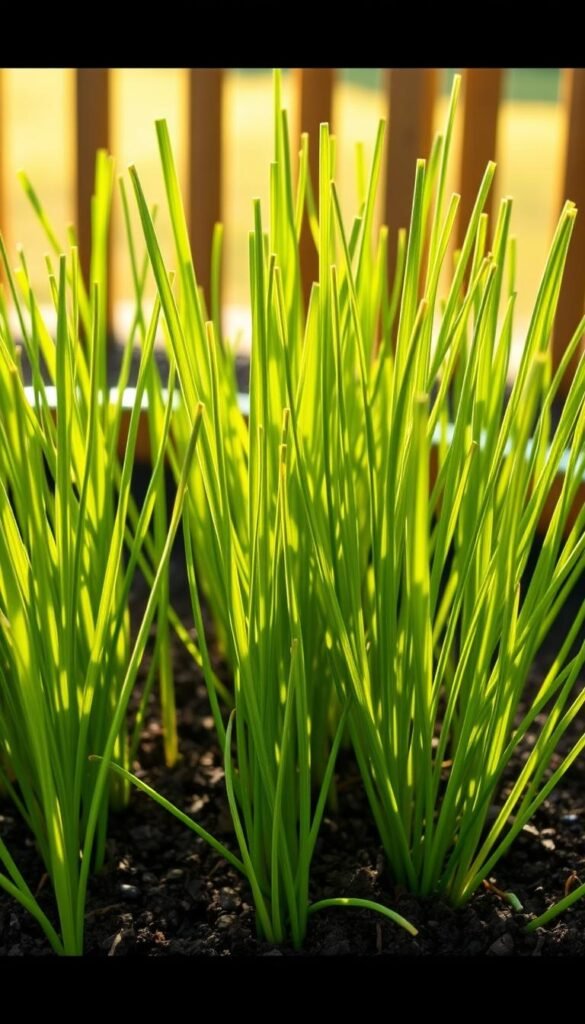
If you want a plant that thrives no matter what, chives are your answer. These hardy greens bounce back from neglect, drought, and even rookie mistakes. Perfect for a raised bed, they’re the ultimate “set and forget” crop.
Why It’s the Easiest Plant to Grow
Chives demand almost nothing. Forget daily watering—they tolerate dry spells.
“My neglected chives outlived my zucchini!”
They sprout early in spring and survive light frosts, giving you fresh flavors for months.
Perennial Growth and Pest-Repelling Powers
Plant once, harvest for years. Chives’ oniony scent naturally deters pests like deer and Japanese beetles. Studies show they repel aphids, making them ideal near lettuce or roses.
Quick Tip: Buy a Starter Plant for Instant Success
Skip seeds; grab a nursery pot. You’ll harvest within weeks. By Year 2, divide overgrown clumps for free plants. Pair with kale or spinach for companion planting magic—they shield each other from bugs.
Lettuce: Fast and Foolproof
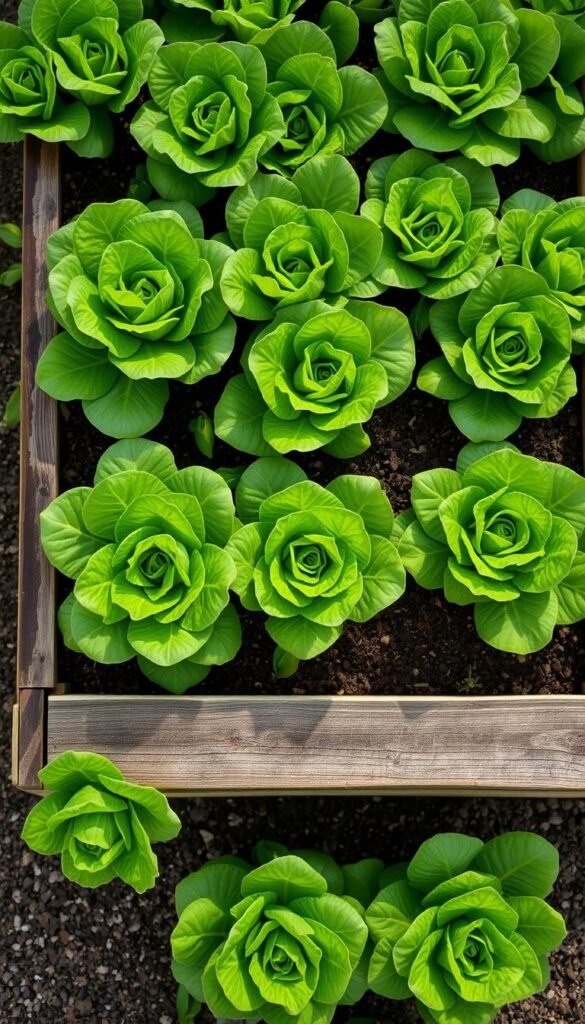
Craving fresh salads without the wait? Lettuce delivers. This leafy green thrives in raised beds, offering speedy results even for first-time growers. With varieties like Buttercrunch resisting bolting, you’ll enjoy tender leaves for months.
Harvest in Just 30 Days
From seed to salad bowl in 4 weeks—lettuce outpaces even radishes. Plant seeds ¼ inch deep, and keep soil moist. Pro tip: Try shade-tolerant Black Seeded Simpson if your garden gets afternoon sun.
Grows in Shade or Sun
Lettuce adapts to light conditions. Morning sun with afternoon shade prevents bitterness in hot climates. For cooler zones, full sun boosts growth. Either way, you’ll harvest sooner than most veggies.
Continuous Harvest with Leaf Snips
Use the cut-and-come-again method: Snip outer leaves, leaving the center to regrow. This extends your growing season by 2–3 months. Avoid overcrowding—space plants 6 inches apart to prevent mold.
“I planted lettuce every two weeks and never bought greens all summer!”
Pair with chives or radishes to maximize your raised bed’s space. With minimal effort, lettuce turns your garden into a salad bar.
Radishes: Speedy and Satisfying
Nothing beats radishes for instant gardening gratification. These crisp veggies can go from seed to plate in as little as 22 days, making them ideal for impatient growers. Plus, their peppery crunch jazzes up salads and snacks.
Ready in 30 Days or Less
Cherry Belle radishes mature fastest—just three weeks. Plant them in loose, well-draining soil with moderate phosphorus. Avoid nitrogen-heavy mixes; they spur leafy tops instead of plump roots.
“My first radish crop was all greens. Now I skip fertilizer and thin seedlings early.”
Multiple Harvests per Season
Sow new rows every 10 days from April to June for nonstop harvests. Radishes thrive in cool weather but turn woody in summer heat. Try these varieties for staggered yields:
| Variety | Days to Harvest | Best For |
|---|---|---|
| Cherry Belle | 22 | Early spring |
| French Breakfast | 28 | Succession planting |
| Watermelon | 60 | Fall crops |
Adds Crunch to Salads—and More
Pair radishes with carrots in your raised bed. Radishes mark rows while slower carrots develop. Love bold flavors? Quick-pickle slices or roast them with honey for a sweet-spicy side.
Just remember: Late-summer planting risks bitter, pithy roots. Stick to spring and fall for the best crops.
Green Beans: Vertical and Prolific
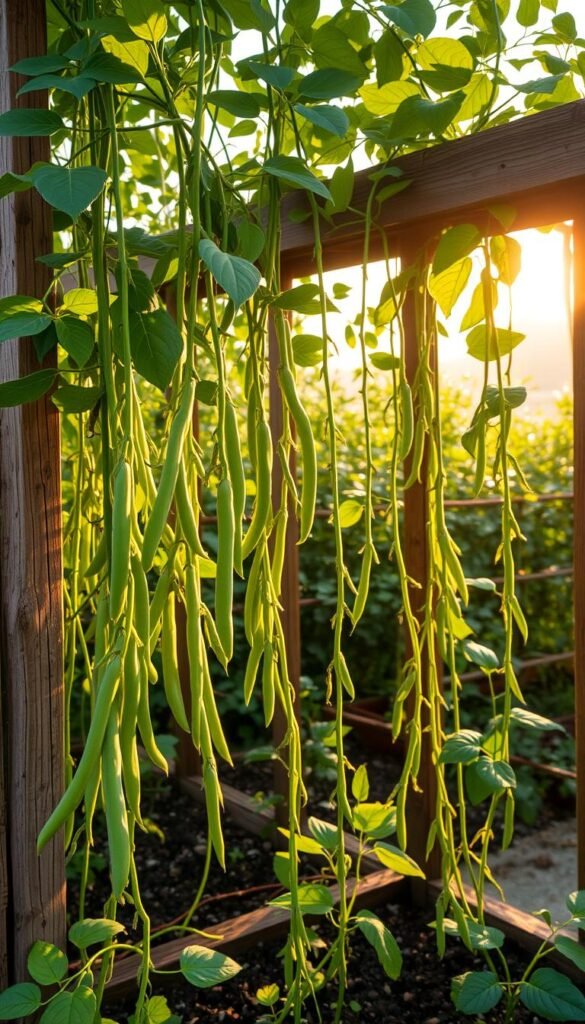
Green beans turn small plots into bountiful harvest zones. These plants thrive in raised beds, offering two growth styles: compact bush types or towering pole varieties. Either way, you’ll enjoy crisp pods all season.
Perfect for Trellises in Small Spaces
Pole beans climb, saving ground space. Train them up a trellis or bamboo teepee—just 6 inches between plants. Bush beans sprawl but need no support. Pro tip: Mix both types for staggered harvests.
Nutrient-Rich and Easy to Pick
Each plant yields 50+ pods. Pick them young for tender flavor. Bonus: Beans fix nitrogen in soil, boosting future crops. Pair with tomatoes or squash to share nutrients naturally.
“My kids hunt for ‘hidden’ beans daily—it’s our favorite garden game!”
Summer Staple for Fresh Meals
Blanch extras for freezing (3 minutes, then seal). Avoid overhead watering to prevent rust fungus. Scarlet runner varieties even attract hummingbirds—a lively garden perk!
Zucchini: The Overachiever
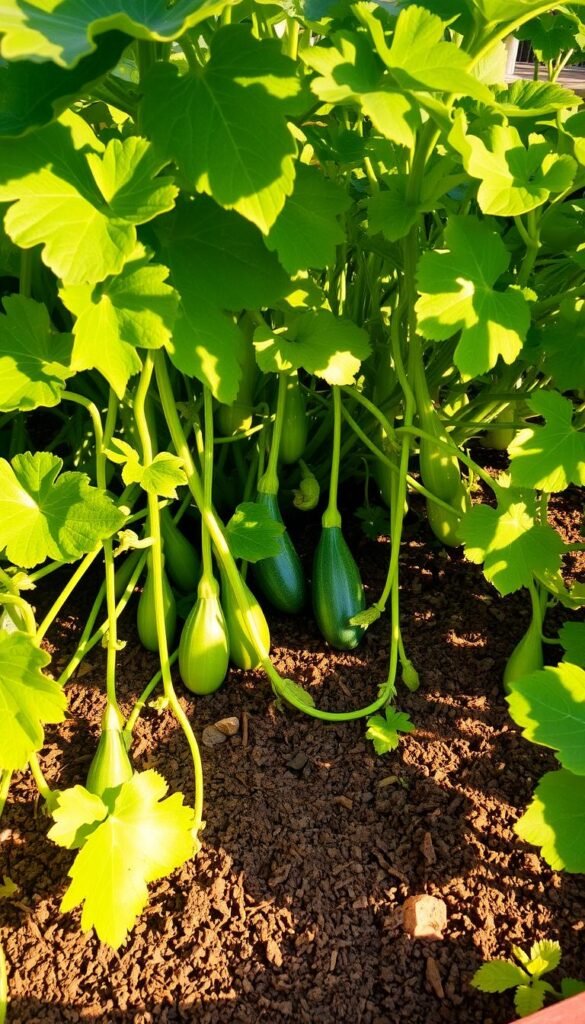
Zucchini plants are the ultimate garden overachievers. They grow fast, produce heavily, and ask for little in return. Even in a small raised bed, one plant can keep your kitchen stocked all summer.
Grows Fast with Minimal Effort
From seed to first harvest in just 45–55 days—zucchini outpaces most veggies. It thrives in warm soil and tolerates minor neglect. Overwatering? That’s the real enemy. Too much moisture causes blossom rot, so let the top inch of soil dry between waterings.
“I planted two zucchini seeds and ended up hosting ‘National Sneak Zucchini onto Your Neighbor’s Porch Night’ by August!”
One Plant Feeds a Family
A single zucchini plant yields 6–10 pounds of produce. For smaller spaces, try compact hybrids like Eight Ball. They resist powdery mildew and fit neatly in corners. Pro tip: Interplant with nasturtiums to repel squash bugs naturally.
| Variety | Days to Harvest | Best Feature |
|---|---|---|
| Black Beauty | 50 | Classic flavor |
| Eight Ball | 45 | Space-saving |
| Golden Zucchini | 55 | Colorful salads |
Versatile in Recipes
Stuck with a surplus? Spiralize and freeze extras for winter soups. Or bake them into bread—overripe zucchinis add moisture and sweetness. If fruits shrivel, hand-pollinate flowers with a paintbrush to boost yields.
Pair zucchini with tomatoes or basil in your garden. They share space well and create a balanced summer harvest. Just remember: compost spent plants in fall to recycle nutrients for next year.
Tomatoes: A Beginner’s Challenge Worth Taking
Growing tomatoes is easier than you think—especially in raised beds. While they need more care than radishes or lettuce, the reward is unmatched. Juicy, sun-warmed tomatoes straight from your garden beat store-bought any day.
Cherry Tomatoes Are Easiest
Start with Sungold or Sweet 100 cherry varieties. These plants produce 100+ fruits each and resist common diseases. Determinate types (bushy) fit small spaces, while indeterminate (vining) needs trellises but yields all season.
“My Sungold vine gave tomatoes until frost—zero fuss!”
Consistent Watering Is Key
Uneven water causes blossom-end rot (black, sunken spots). Use drip irrigation or water deeply 2–3 times weekly. Mulch keeps soil moist and prevents splashing—a trick to avoid soil-borne diseases.
Support with Cages or Trellises
Heavy tomato vines collapse without support. Try the DIY Florida weave:
| Method | Materials | Best For |
|---|---|---|
| Florida Weave | Twine + stakes | Rows of plants |
| Cages | Metal/concrete wire | Bush varieties |
| Teepee Trellis | Bamboo poles | Small gardens |
Remove lower leaves to improve airflow. Pair with basil—it repels hornworms and boosts flavor. With these tips, your tomatoes will thrive!
Carrots: Low-Maintenance and Sweet
Carrots bring sweet rewards with minimal effort—perfect for new gardeners. These crunchy crops adapt well to raised beds, where loose soil lets roots grow straight and deep. Plus, frost sweetens them naturally—a tasty bonus!
Thin Seedlings for Best Results
Overcrowding leads to stunted carrots. Once sprouts hit 2 inches, snip extras with scissors—don’t pull! This avoids disturbing nearby roots. Pro tip: Use pelleted seeds for easier spacing.
“Thinning felt harsh, but my carrots grew twice as big!”
Harvest Baby or Wait for Frost
Pick young carrots for tender bites, or leave them until after frost. Cold time converts starches to sugars, creating the sweetest harvest. Danvers varieties handle heavy soil best.
Store All Winter in the Ground
In mild climates, mulch carrots with straw and harvest as needed. For colder zones, layer unwashed carrots in damp sand in a cool basement. Avoid fresh manure—it causes forked roots.
- Rainbow varieties: Try Cosmic Purple for vibrant salads.
- Soil prep: Mix sand into clay beds for better drainage.
Spinach and Swiss Chard: Leafy Greens That Keep Giving
For steady garden yields, few plants match spinach and Swiss chard. These nutritious greens adapt to changing weather, offering multiple harvests from one planting. Whether you prefer tender baby leaves or mature bunches, they’re perfect for raised beds.
Spinach Loves Cool Weather
Plant spinach when temperatures dip below 70°F. It matures in just 40 days—ideal for quick season turnarounds. Winter Giant survives under row covers until -10°F.
Harvest outer leaves at 3 inches for mix-and-match salads. The more you pick, the more it grows!
Swiss Chard Resists Bolting
Unlike kale, chard won’t bolt in summer heat. It withstands -15°F winters too. Cover seedlings with netting to protect from birds.
“My Rainbow chard produced for 18 months straight—through snow and drought!”
Rainbow Varieties Add Color
Bright stems aren’t just pretty—they’re edible. Try these uses:
- Pickle stems for tangy crunch
- Sauté leaves with garlic
- Add raw to smoothies
| Variety | Days to Harvest | Key Benefit |
|---|---|---|
| Winter Giant Spinach | 40 | Cold-hardy |
| Rainbow Swiss Chard | 55 | Colorful stems |
| Perpetual Spinach | 60 | Cut-and-come-again |
Nutritionally, chard packs more magnesium, while spinach leads in iron. Both outshine lettuce for vitamin K. Plant them together for a garden that keeps giving!
Kale and Beets: Cold-Hardy Superstars
Winter doesn’t have to mean empty garden beds—kale and beets thrive in the cold. These resilient crops shrug off frost and keep producing when others quit. Perfect for raised beds, they’re low-fuss and high-reward.
Kale Thrives in Cool Seasons
Lacinato kale survives temperatures as low as -10°F, making it a winter warrior. For tender leaves, try Red Russian—its purple veins add color to salads. Cold weather even mellows kale’s bitterness.
- Harvest outer leaves first; the center keeps growing.
- Pair with garlic or onions to deter pests naturally.
Beets Offer Two Harvests
Snip beet greens early for salads—they’re packed with more nutrients than the roots. Leave the plant intact, and you’ll get plump beets later. Frost converts their starches to sugars, creating a candy-like sweetness.
“I roasted frost-kissed beets with goat cheese—game-changer!”
For continuous yields, plant every 3 weeks until July. Avoid nitrogen-heavy soil—it grows giant leaves but tiny roots.
Sweetens After Frost
Both kale and beets taste better after cold snaps. In mild climates, mulch them and harvest all winter. For storage, layer unwashed beets in damp sand—they’ll last months.
| Variety | Cold Tolerance | Best Use |
|---|---|---|
| Lacinato Kale | -10°F | Stews, chips |
| Detroit Dark Red Beets | 30°F | Roasting, pickling |
Pro tip: Interplant with chives to maximize space and deter bugs. Cold weather just makes these crops sweeter—no green thumb required!
Pro Tips for Your Raised Bed Success
Smart planning turns your raised bed into a powerhouse of productivity. Pair the right plants, nurture your soil, and dodge common errors to enjoy bumper harvests. Here’s how to optimize every inch.
Companion Planting Ideas
Some plants thrive together like old friends. Marigolds repel nematodes, while mint (in pots!) keeps ants away. Try these winning pairs:
- Tomatoes + basil: Enhances flavor and deters hornworms.
- Carrots + onions: Onions mask carrot flies’ scent.
- Beans + corn: Beans climb cornstalks, fixing nitrogen below.
“My marigold border cut aphids by 80%—no sprays needed!”
Soil and Watering Basics
Test your soil pH (aim for 6.0–7.0) with a $12 kit. Mix in compost annually for nutrients. For water efficiency:
- Use drip irrigation on a timer to prevent drought stress.
- Mulch with straw to retain moisture and block weeds.
Try lasagna composting: Layer greens (kitchen scraps) and browns (leaves) directly in beds. It builds fertile soil over time.
Avoid These Common Mistakes
Even small missteps can curb yields. Watch for:
- Overcrowding: Thin seedlings early to prevent stunted growth.
- Ignoring crop rotation: Swap plant families yearly to foil diseases.
- Over-fertilizing: Excess nitrogen burns roots—stick to compost.
With these tweaks, your garden will outshine store-bought produce. Ready to dig deeper?
Get Started Today and Reap the Rewards!
Your journey to fresh, homegrown flavors starts now. Order seeds tonight—your future harvest begins with a single click. Don’t overthink it; even failed zucchini teach valuable lessons.
Swap extras at local seed libraries or share with neighbors. Gardening thrives on community. Want a cheat sheet? Grab our free planting calendar to time your raised bed success.
Your first salad, plucked straight from the garden, is weeks away. Mistakes? They’re part of the process. Every pro once buried seeds too deep or forgot to water.
Soil under your nails, sun on your back—that’s the real reward. Your raised bed is ready. Let’s grow!

